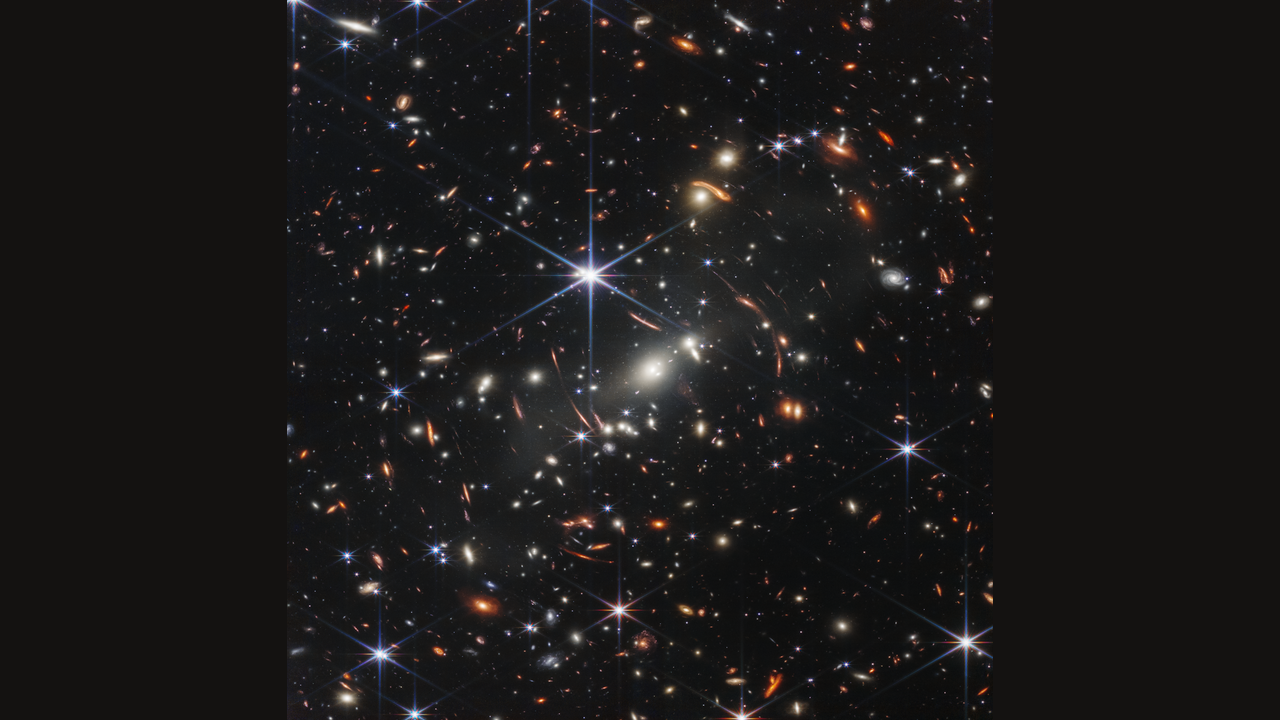
Date:
Image source: NASA, ESA, CSA, STScI
This first image from James Webb Space Telescope was released July 11. The Webb science and engineering team was recognized for extraordinary work but not much was said about the image itself, except that it shows some of the oldest light ever seen by humans. Let’s go further toward understanding what the image actually shows. Here’s how to interpret this first JWST ultra-deep field image:
What we see at first glance are bright stars, some small spiral galaxies, and lots of smaller blobs ranging in color from tan to red.
The stars are obvious; bright bluish-white dots with eight spikes. The spikes are caused by starlight spilling around the mechanism that holds the telescope mirrors in place. These stars are located quite close by. They are the only objects in the picture that are in our home galaxy, the Milky Way. Every other object in the picture is outside our galaxy. In fact, every one of the fuzzy blobs shown is a galaxy!
As you look closer, notice the size, brightness, shape, and color of the blobs. Some are larger and brighter than others. Some are clearly defined and show spiral structure, like a pinwheel. Some are orange or red in color. Some look like wispy dust bunnies, barely visible at all. They are all galaxies, collections of hundreds of millions of stars each!
Differences in size or brightness may be due to distance. The farther away an object is, the smaller and dimmer in may appear. More information about the light from the object is needed to determine for sure just how bright or far away it might be, but these are your first cues for relative distance and size.
The ‘fuzzy’ factor in a galaxy’s appearance might be caused by the type of galaxy it is. Galaxies are classified by how well their structure is defined. The least structured galaxies are classified as spherical or irregular, they show very little structure, their name describes their shape. The most structured galaxies are the spiral galaxies. They show distinct spiral arms and even bars or bridge-like structure across their central region.
My favorite factor to observe is color. In this image, color is an indicator of how far and how fast a galaxy is moving away from the observer. Really distant galaxies move out faster than closer galaxies do. The farther out a galaxy is, the faster it moves out and the redder it appears. A critical concept to keep in mind is that it’s not so much how fast the galaxy is moving through space but how fast the universe is expanding and carrying the galaxies with it as it expands.
Finally, what are the curved blobs seen near the center of the image? These are distorted images of extremely distant galaxies directly behind a cluster of galaxies at the center of the full image. The galactic cluster is so heavy (massive) that light from behind it is bent around it, allowing us to see other galaxies directly behind. This process is called gravitational lensing and was predicted by physicist Albert Einstein over 100 years ago. It’s like using a cluster of galaxies as a telescope to see even farther!
So this first image shows us a tiny section of night sky, looking farther out than humans have ever seen before. We see thousands of galaxies, home to billions of stars, solar systems (and maybe inhabitants!) showing us what this part of the universe looked like more than 13 billion years ago.
What will the telescope show us? Hopefully, with information gathered by JWST, astronomers will be able to dig deeper into the universe’s past to try to unravel secrets about its origin. This look back towards the earliest time in the universe will help astronomers better understand how it has developed since its beginning, its fate, and possibly, its inhabitants.
https://webb.nasa.gov/index.html
https://www.nasa.gov/webbfirstimages
https://webb.nasa.gov/content/webbLaunch/whereIsWebb.html


